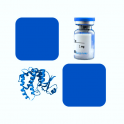
- Remove this product from my favorite's list.
- Add this product to my list of favorites.
Products
Viewed products
Newsletter
 |  |  |  |  |  |

Background
CD40 ligand is also known as CD40L, CD154, TNFSF5 and T-cell antigen Gp39, is a single-pass type I I membrane protein which belongs to the TNF superfamily of molecules. CD40 ligand is expressed predominantly on activated CD4+ T lymphocytes, and also found in other types of cells, including platelets, mast cells, macrophages, basophils, NK cells, B lymphocytes, as well as non-haematopoietic cells (smooth muscle cells, endothelial cells, and epithelial cells). Although all monomeric, dimeric and trimeric forms of soluble CD40 ligand can bind to CD40, the trimeric form of soluble CD40 ligand has the most potent biological activity through oligomerization of cell surface CD40, a common feature of TNF receptor family members. CD40 ligand binds to CD40 on antigen-presenting cells (APC), which leads to many effects depending on the target cell type. In general, CD40 ligand plays the role of a costimulatory molecule and induces activation in APC in association with T cell receptor stimulation by MHC molecules on the APC. In total CD40 ligand has three binding partners: CD40, α5β1 integrin and αIIbβ3. CD40 ligand regulates B cell function by engaging CD40 on the B cell surface. A defect in this gene results in an inability to undergo immunoglobulin class switch and is associated with hyper IgM syndrome.
Source
Recombinant mouse CD40 Ligand / TNFSF5 Protein (Mouse CD40 Ligand), His Tag (active trimer) (MALS verified) (CDL-M5248) is expressed from human 293 cells (HEK293). It contains AA Gly 115 - Leu 260 (Accession # P27548-1).
Predicted N-terminus: His
Molecular Characterization
This protein carries a polyhistidine tag at the N-terminus.
The protein has a calculated MW of 16.8 kDa. The protein migrates as 19-22 kDa when calibrated against Star Ribbon Pre-stained Protein Marker under reducing (R) condition (SDS-PAGE).
Endotoxin
Less than 1.0 EU per μg by the LAL method.
Purity
>95% as determined by SDS-PAGE.
>95% as determined by SEC-MALS.
Formulation
Lyophilized from 0.22 μm filtered solution in PBS, pH7.4 with trehalose as protectant.
Reconstitution
Please see Certificate of Analysis for specific instructions.
For best performance, we strongly recommend you to follow the reconstitution protocol provided in the CoA.
Storage
For long term storage, the product should be stored at lyophilized state at -20°C or lower.
Please avoid repeated freeze-thaw cycles.
This product is stable after storage at:
-20°C to -70°C for 12 months in lyophilized state;
-70°C for 3 months under sterile conditions after reconstitution.
Bioactivity
Please refer to product data sheet.
(1) "Identification of immune cell markers associated with ulcerative colitis histological disease activity in colonic biopsies"
Lefevre, Wang, Teft et al
J Clin Pathol (2024)
(2) "Immunoprecipitation and FRET-FLIM to Determine Metabolons on the Plant ER"
Kriechbaumer, Botchway
Methods Mol Biol (2024) 2772, 169-177
(3) "Assessment of serum soluble CD40 ligand levels in patients with chronic rhinosinusitis"
Liu, Fan, Zhou et al
World Allergy Organ J (2024) 17 (3), 100880
Showing 1-3 of 8346 papers.
Follow us